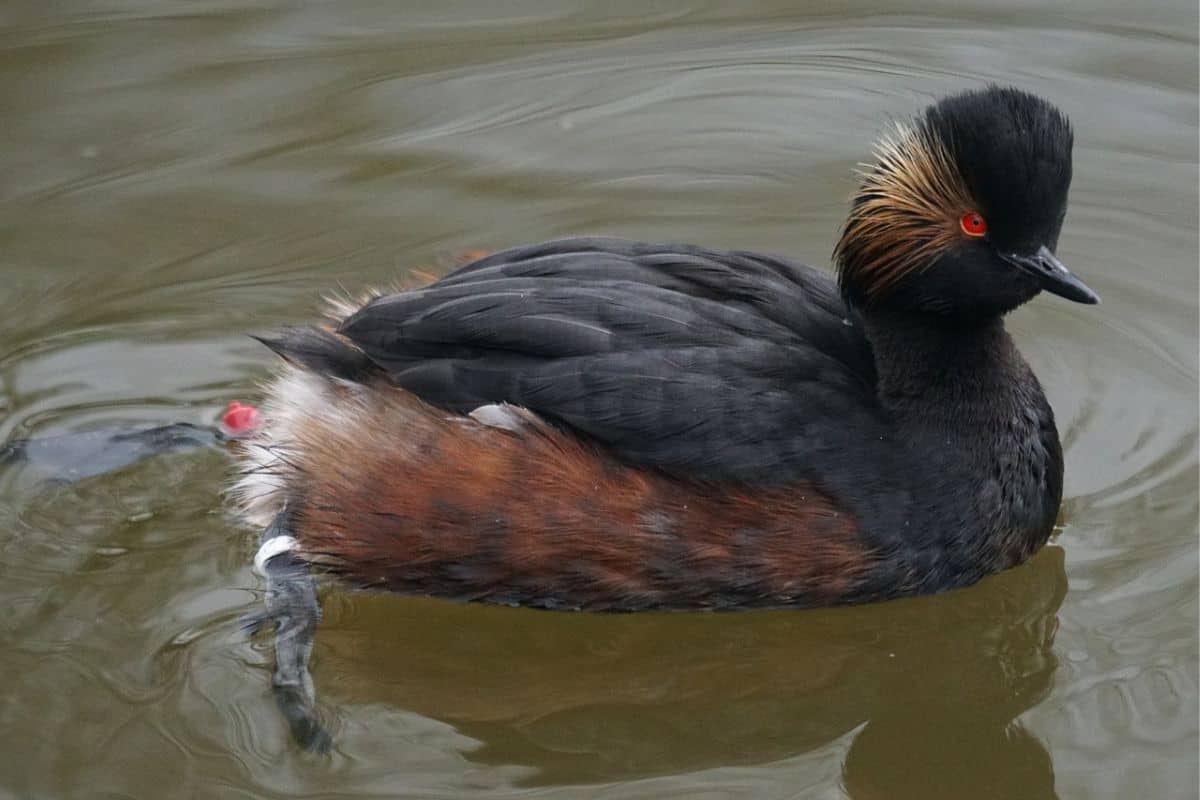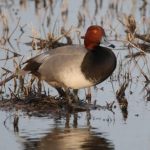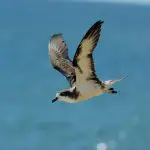Common Name: Eared Grebe
Scientific Name: Podiceps nigricollis| Size | Diet | Range in Hawaii | Status in Hawaii |
|---|---|---|---|
| 12 in. | small fish and aquatic invertebrates | Kaua'i, Maui, and Oahu | Least Concern |
The Black-necked Grebe or Eared Grebe (Podiceps nigricollis) is a small water bird species known for its distinctive ear-like feathers and striking black and white plumage. These graceful swimmers are found in freshwater and saline lakes across North America and Eurasia during their breeding season.
While they are not known to breed in Hawaii, they have been spotted as non-breeding visitors and vagrants in the state during their migration season. With their unique appearance and impressive diving abilities, Black-necked Grebes are a favorite among birdwatchers and nature enthusiasts.
However, like many other bird species, they face threats from habitat loss, pollution, and climate change, making conservation efforts crucial for their survival. In this article, we will explore the fascinating world of the Black-necked Grebe and the importance of protecting this beautiful species.
Black-necked Grebe
Appearance

The Black-necked Grebe is a small water bird known for its distinctive appearance. With a body length of approximately 12 inches (30 centimeters), it falls within the smaller range of grebe species.
The Black-necked Grebe has a slim, elongated body and a graceful posture while swimming. Its plumage is predominantly black, with a white underside and a sharply defined black cap on its head. One of its most prominent features is its reddish-orange eyes, which provide a striking contrast against its dark feathers.
During breeding season, the Black-necked Grebe develops decorative plumes on the sides of its head, giving the impression of “ears” from which it derives its common name. These plumes are vibrant in color, ranging from golden yellow to cinnamon brown.
Diet
The Black-necked Grebe has a diet primarily consisting of small fish and aquatic invertebrates. As a proficient swimmer and diver, it uses its slender neck and pointed bill to capture its prey.
The grebe’s diet is essential for sustaining its energy levels and maintaining its small, sleek physique. By feeding on these aquatic organisms, the Black-necked Grebe demonstrates its adaptation to an aquatic lifestyle and its ability to thrive in its watery habitats.
Nesting
The nesting behavior of the Black-necked Grebe is a remarkable spectacle. These water birds typically build their nests on floating platforms made of aquatic vegetation, such as reeds and rushes. The nests are constructed in shallow water near the edges of lakes, ponds, or marshes.
During the breeding season, the Black-necked Grebes form large colonies, often consisting of hundreds or even thousands of individuals. Within these colonies, pairs of grebes engage in courtship displays to establish and reinforce their bond.
These displays involve elaborate rituals of head shaking, synchronized swimming, and “rushing” across the water’s surface. Once a pair has formed, they work together to build their nest. Both male and female participate in the construction process, with the male often gathering the materials while the female arranges them into a sturdy structure.
The nests are designed to float, allowing them to adjust to changing water levels. Black-necked Grebes are known for their clever nesting strategy called “submergent nesting.” This means that their nests are partially submerged, providing protection against potential predators such as raccoons or foxes.
The submerged nests also provide stability, preventing them from being easily toppled by wind or waves. After the nest is completed, the female lays a clutch of eggs, usually consisting of 3 to 5 eggs.
Both parents take turns incubating the eggs, sharing the responsibility of keeping them warm and protected. Once the eggs hatch, the parents continue to care for the chicks, feeding them a diet of small invertebrates until they are ready to fledge and explore the water on their own.
Behavior
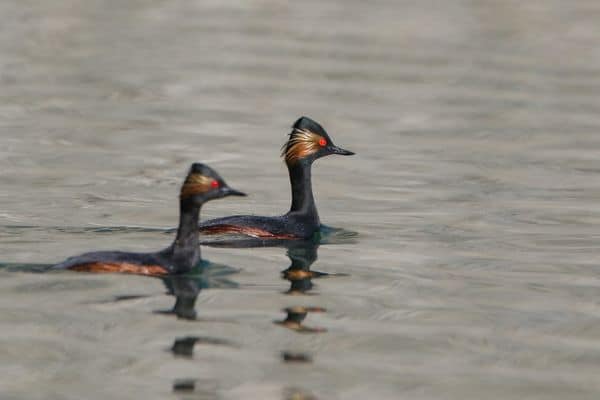
The Black-necked Grebe displays a variety of fascinating behaviors that reflect its adaptation to its watery environment. These water birds are skilled divers and swimmers, spending the majority of their time on the water. Their behavior often involves elaborate courtship displays during the breeding season.
Black-necked Grebes are known for their synchronized swimming performances, where pairs or groups of grebes move in unison across the water’s surface. These displays can be quite elaborate and include head shaking, wing flapping, and “rushing” movements. These displays serve as both a bonding mechanism between mates and a way to defend their territory.
When it comes to feeding, the Black-necked Grebe employs its remarkable diving abilities. It can dive underwater to pursue small fish and aquatic invertebrates, using its lobed feet for propulsion. It can stay submerged for extended periods, resurfacing with its catch in its bill.
Outside of the breeding season, Black-necked Grebes are often found in large flocks, sometimes numbering in the thousands. These flocks can engage in synchronized swimming and diving, creating mesmerizing patterns on the water’s surface.
Despite their aquatic prowess, Black-necked Grebes are not as agile on land. They have difficulty walking and take to the air only when necessary or during migration.
Habitat
These water birds are well adapted to a variety of wetland habitats and can be found in both natural and human-made bodies of water. Black-necked Grebes are particularly drawn to areas with abundant vegetation, as it provides them with nesting materials and hiding places for their nests. They often select nesting sites in areas with emergent vegetation or floating vegetation mats.
These habitats offer protection and stability for their nests, as well as a source of food. During the non-breeding season, Black-necked Grebes can be found in larger bodies of water such as reservoirs, brackish estuaries, and coastal bays.
They may also utilize saltwater habitats, including inland saline lakes and coastal lagoons. The availability of suitable food sources is a crucial factor in the habitat selection of Black-necked Grebes. They prefer habitats with an abundance of small fish and aquatic invertebrates, as these form the mainstay of their diet.
Range
According to the Hawaii Bird Records Committee, the Black-necked Grebe is a non-breeding visitor and vagrant in Hawaii. They have been spotted in several locations across the state, including Kaua’i, Maui, and Oahu, during their migration season, which typically occurs between October and April.
While they do not breed in Hawaii, their presence as visitors and vagrants adds to the diversity of bird species found in the state. However, it is important to note that Black-necked Grebes, like many other bird species, face threats from habitat loss and pollution, making conservation efforts crucial for their survival.
Conservation Status
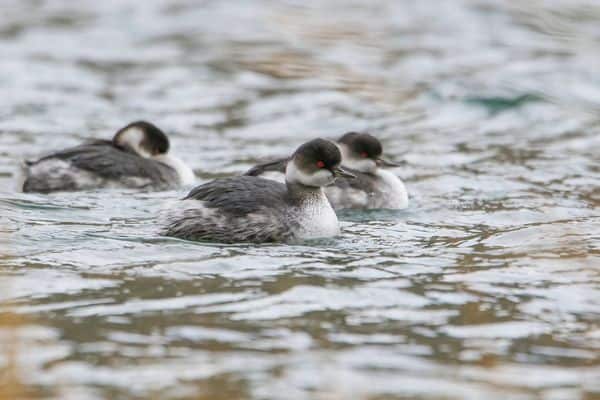
The conservation status of the Black-necked Grebe varies depending on the region. In Europe, the IUCN (International Union for Conservation of Nature) has listed the Black-necked Grebe as “Vulnerable” due to concerns about its population decline and habitat degradation in certain parts of its range.
The reasons for the vulnerable status in Europe include habitat loss and degradation, disturbance by human activities, pollution, and the impact of climate change. These factors have contributed to a decline in suitable breeding and foraging habitats for the Black-necked Grebe in some European countries.
On a global scale, however, the Black-necked Grebe is currently listed as “Least Concern” by the IUCN. This designation indicates that the species, as a whole, does not face a significant risk of extinction at the global level. The Black-necked Grebe has a relatively large population and a wide distribution range across North America, Europe, and Asia, which helps to maintain its overall conservation status.
Interesting Facts
1. Unique courtship display
During the breeding season, Black-necked Grebes partake in intricate courtship displays that involve synchronized swimming and darting across the water’s surface. These displays not only strengthen the bond between mates but also serve as a means to protect their territories.
2. Large breeding colonies
Throughout the breeding season, Black-necked Grebes form expansive colonies, frequently comprising hundreds or even thousands of individuals. These colonies provide valuable benefits such as protection, opportunities for social interaction, and heightened prospects for successful breeding.
3. Excellent diving abilities
Black-necked Grebes are superb divers, capable of diving to considerable depths to pursue prey. Their lobed feet and streamlined bodies allow them to swim and maneuver underwater with ease.
4. Vocalization
While generally silent, Black-necked Grebes produce a variety of calls during the breeding season, including soft croaks, growls, and trills. These vocalizations are used for communication between mates and during territorial disputes.
5. Unique nesting strategy
Black-necked Grebes practice “submergent nesting,” where they build their nests on floating platforms made of vegetation. These nests are partially submerged, providing protection against predators and adapting to changing water levels.
Frequently Asked Questions
1. Are Black-necked Grebes social birds?
Yes, Black-necked Grebes are known to gather in large colonies during the breeding season. These colonies offer protection, social interaction, and increased breeding success.
2. Do Black-necked Grebes fly?
Black-necked Grebes are capable of flight, but they spend the majority of their time swimming and diving. They typically take to the air for migration purposes or when necessary.
3. How do Black-necked Grebes communicate?
Black-necked Grebes have various vocalizations, including soft croaks, growls, and trills, which are used for communication between mates and during territorial disputes.
4. How long do Black-necked Grebes typically live?
Black-necked Grebes have an average lifespan of around 7 to 10 years in the wild. However, some individuals have been known to live for more than 15 years.
